Curtin University Health Promotion: Ethical Frameworks Analysis
VerifiedAdded on 2023/01/16
|7
|1715
|41
Essay
AI Summary
This essay delves into the ethical dimensions of health promotion, particularly focusing on the balance between individual liberty and public health. The analysis begins by exploring the ethical justification for government interventions, using smoking as a case study, and considers the tension between individual rights and the collective well-being. The essay then examines the risks associated with health promotion professionals lacking a strong understanding of ethical principles, including issues of coercion, privacy, and informed consent. It emphasizes the importance of ethical frameworks like beneficence, non-maleficence, respect for persons, and justice in guiding health promotion practices. The essay stresses the need for transparency, inclusivity, and honest communication to build trust and establish effective relationships with the public, ultimately aiming to mitigate ethical issues and promote positive health outcomes.
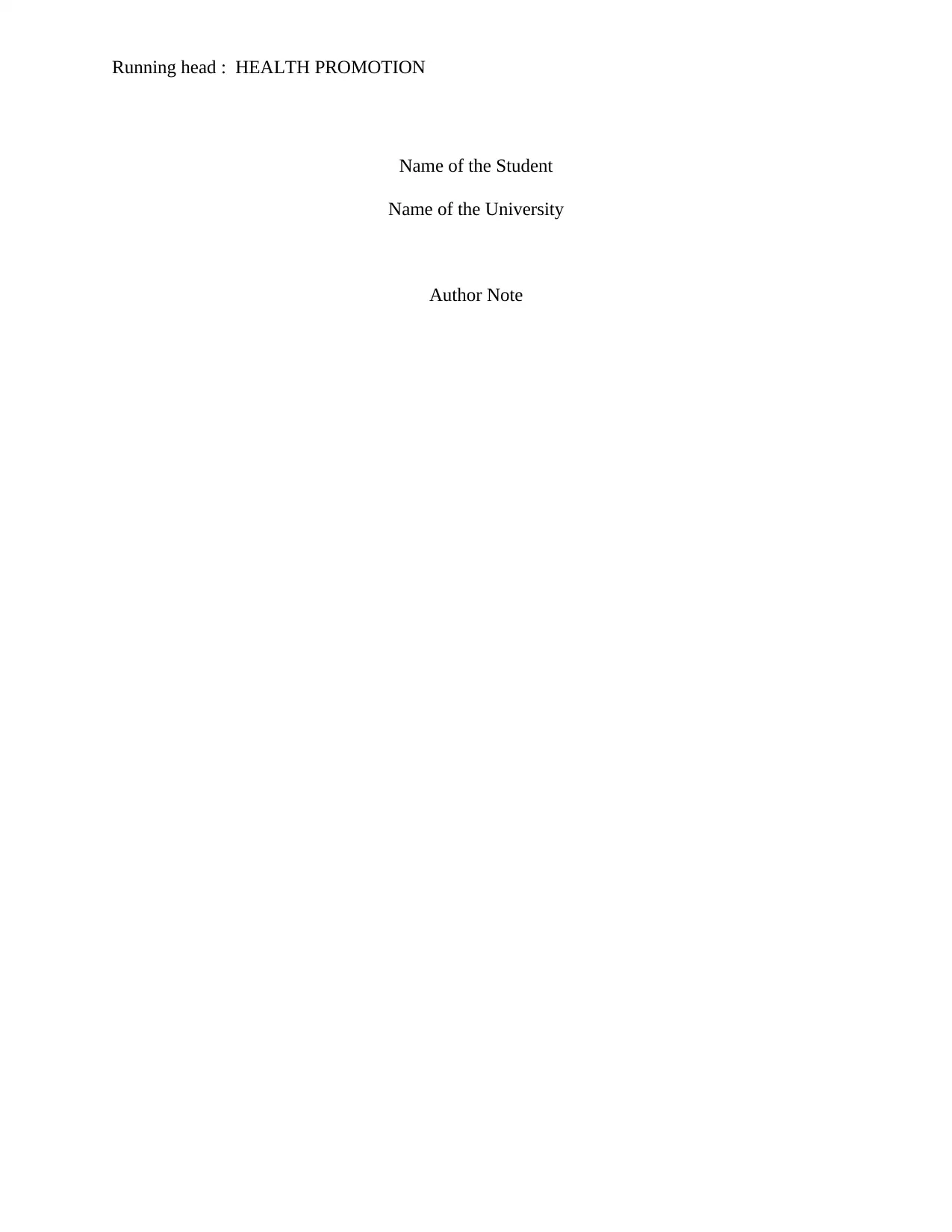
Running head : HEALTH PROMOTION
Name of the Student
Name of the University
Author Note
Name of the Student
Name of the University
Author Note
Paraphrase This Document
Need a fresh take? Get an instant paraphrase of this document with our AI Paraphraser
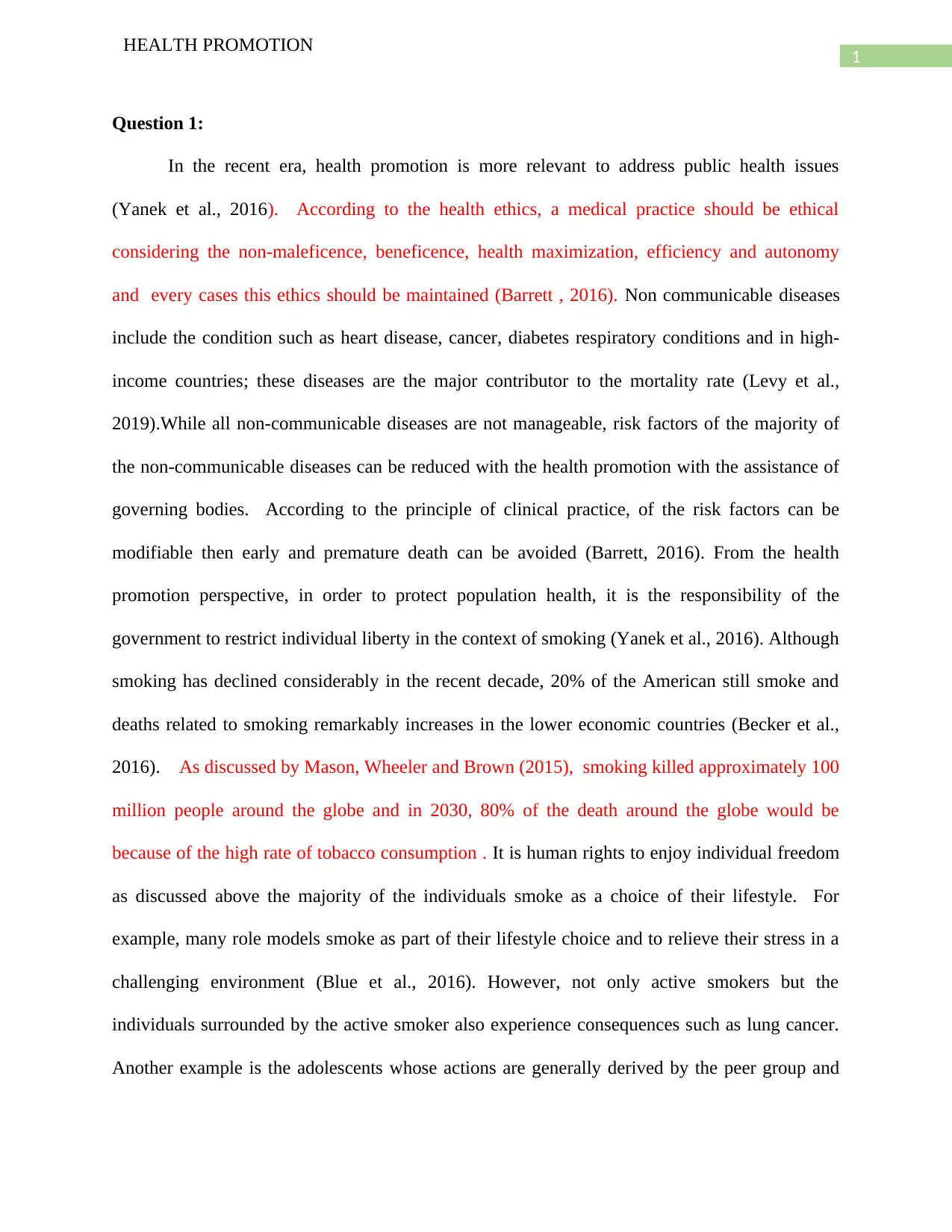
1
HEALTH PROMOTION
Question 1:
In the recent era, health promotion is more relevant to address public health issues
(Yanek et al., 2016). According to the health ethics, a medical practice should be ethical
considering the non-maleficence, beneficence, health maximization, efficiency and autonomy
and every cases this ethics should be maintained (Barrett , 2016). Non communicable diseases
include the condition such as heart disease, cancer, diabetes respiratory conditions and in high-
income countries; these diseases are the major contributor to the mortality rate (Levy et al.,
2019).While all non-communicable diseases are not manageable, risk factors of the majority of
the non-communicable diseases can be reduced with the health promotion with the assistance of
governing bodies. According to the principle of clinical practice, of the risk factors can be
modifiable then early and premature death can be avoided (Barrett, 2016). From the health
promotion perspective, in order to protect population health, it is the responsibility of the
government to restrict individual liberty in the context of smoking (Yanek et al., 2016). Although
smoking has declined considerably in the recent decade, 20% of the American still smoke and
deaths related to smoking remarkably increases in the lower economic countries (Becker et al.,
2016). As discussed by Mason, Wheeler and Brown (2015), smoking killed approximately 100
million people around the globe and in 2030, 80% of the death around the globe would be
because of the high rate of tobacco consumption . It is human rights to enjoy individual freedom
as discussed above the majority of the individuals smoke as a choice of their lifestyle. For
example, many role models smoke as part of their lifestyle choice and to relieve their stress in a
challenging environment (Blue et al., 2016). However, not only active smokers but the
individuals surrounded by the active smoker also experience consequences such as lung cancer.
Another example is the adolescents whose actions are generally derived by the peer group and
HEALTH PROMOTION
Question 1:
In the recent era, health promotion is more relevant to address public health issues
(Yanek et al., 2016). According to the health ethics, a medical practice should be ethical
considering the non-maleficence, beneficence, health maximization, efficiency and autonomy
and every cases this ethics should be maintained (Barrett , 2016). Non communicable diseases
include the condition such as heart disease, cancer, diabetes respiratory conditions and in high-
income countries; these diseases are the major contributor to the mortality rate (Levy et al.,
2019).While all non-communicable diseases are not manageable, risk factors of the majority of
the non-communicable diseases can be reduced with the health promotion with the assistance of
governing bodies. According to the principle of clinical practice, of the risk factors can be
modifiable then early and premature death can be avoided (Barrett, 2016). From the health
promotion perspective, in order to protect population health, it is the responsibility of the
government to restrict individual liberty in the context of smoking (Yanek et al., 2016). Although
smoking has declined considerably in the recent decade, 20% of the American still smoke and
deaths related to smoking remarkably increases in the lower economic countries (Becker et al.,
2016). As discussed by Mason, Wheeler and Brown (2015), smoking killed approximately 100
million people around the globe and in 2030, 80% of the death around the globe would be
because of the high rate of tobacco consumption . It is human rights to enjoy individual freedom
as discussed above the majority of the individuals smoke as a choice of their lifestyle. For
example, many role models smoke as part of their lifestyle choice and to relieve their stress in a
challenging environment (Blue et al., 2016). However, not only active smokers but the
individuals surrounded by the active smoker also experience consequences such as lung cancer.
Another example is the adolescents whose actions are generally derived by the peer group and
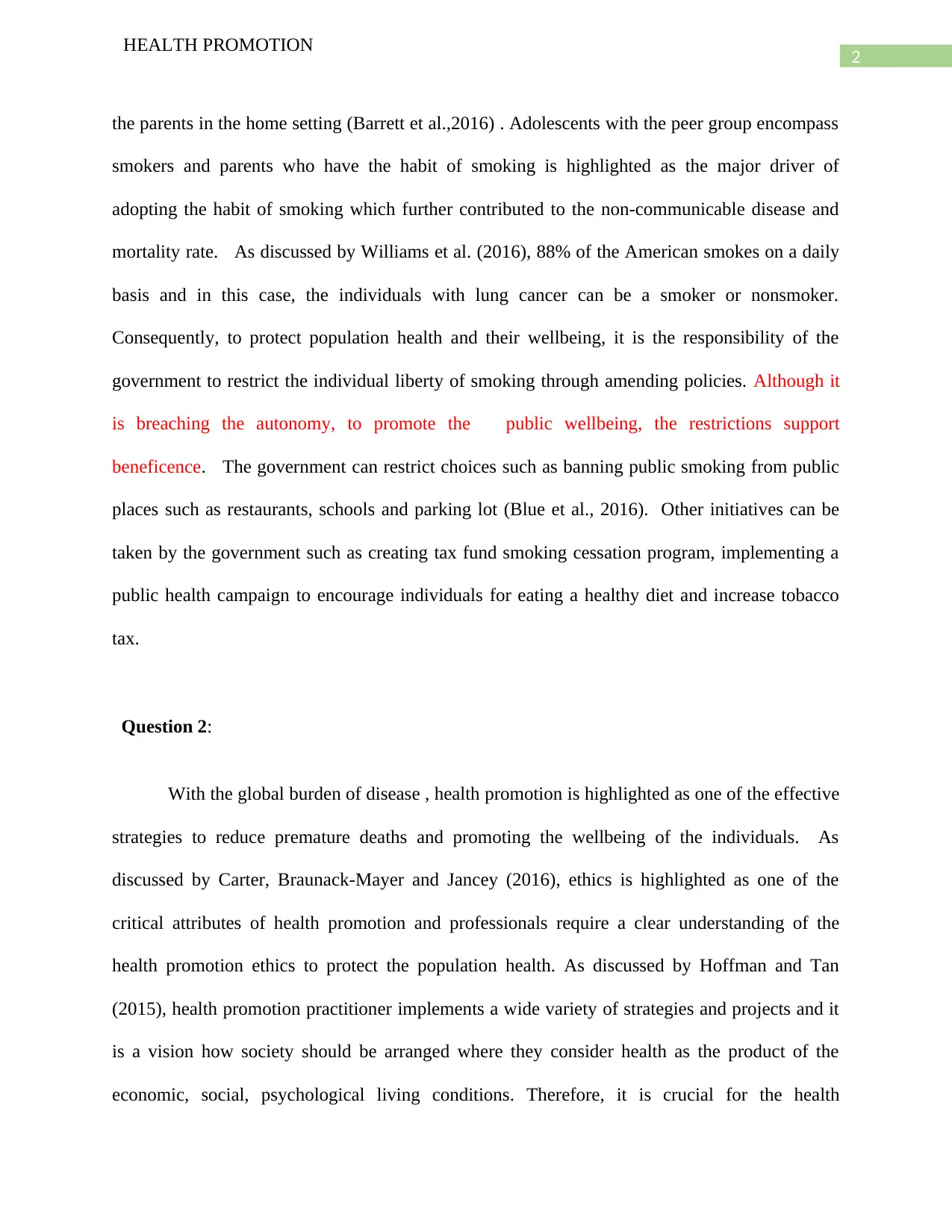
2
HEALTH PROMOTION
the parents in the home setting (Barrett et al.,2016) . Adolescents with the peer group encompass
smokers and parents who have the habit of smoking is highlighted as the major driver of
adopting the habit of smoking which further contributed to the non-communicable disease and
mortality rate. As discussed by Williams et al. (2016), 88% of the American smokes on a daily
basis and in this case, the individuals with lung cancer can be a smoker or nonsmoker.
Consequently, to protect population health and their wellbeing, it is the responsibility of the
government to restrict the individual liberty of smoking through amending policies. Although it
is breaching the autonomy, to promote the public wellbeing, the restrictions support
beneficence. The government can restrict choices such as banning public smoking from public
places such as restaurants, schools and parking lot (Blue et al., 2016). Other initiatives can be
taken by the government such as creating tax fund smoking cessation program, implementing a
public health campaign to encourage individuals for eating a healthy diet and increase tobacco
tax.
Question 2:
With the global burden of disease , health promotion is highlighted as one of the effective
strategies to reduce premature deaths and promoting the wellbeing of the individuals. As
discussed by Carter, Braunack-Mayer and Jancey (2016), ethics is highlighted as one of the
critical attributes of health promotion and professionals require a clear understanding of the
health promotion ethics to protect the population health. As discussed by Hoffman and Tan
(2015), health promotion practitioner implements a wide variety of strategies and projects and it
is a vision how society should be arranged where they consider health as the product of the
economic, social, psychological living conditions. Therefore, it is crucial for the health
HEALTH PROMOTION
the parents in the home setting (Barrett et al.,2016) . Adolescents with the peer group encompass
smokers and parents who have the habit of smoking is highlighted as the major driver of
adopting the habit of smoking which further contributed to the non-communicable disease and
mortality rate. As discussed by Williams et al. (2016), 88% of the American smokes on a daily
basis and in this case, the individuals with lung cancer can be a smoker or nonsmoker.
Consequently, to protect population health and their wellbeing, it is the responsibility of the
government to restrict the individual liberty of smoking through amending policies. Although it
is breaching the autonomy, to promote the public wellbeing, the restrictions support
beneficence. The government can restrict choices such as banning public smoking from public
places such as restaurants, schools and parking lot (Blue et al., 2016). Other initiatives can be
taken by the government such as creating tax fund smoking cessation program, implementing a
public health campaign to encourage individuals for eating a healthy diet and increase tobacco
tax.
Question 2:
With the global burden of disease , health promotion is highlighted as one of the effective
strategies to reduce premature deaths and promoting the wellbeing of the individuals. As
discussed by Carter, Braunack-Mayer and Jancey (2016), ethics is highlighted as one of the
critical attributes of health promotion and professionals require a clear understanding of the
health promotion ethics to protect the population health. As discussed by Hoffman and Tan
(2015), health promotion practitioner implements a wide variety of strategies and projects and it
is a vision how society should be arranged where they consider health as the product of the
economic, social, psychological living conditions. Therefore, it is crucial for the health
⊘ This is a preview!⊘
Do you want full access?
Subscribe today to unlock all pages.

Trusted by 1+ million students worldwide
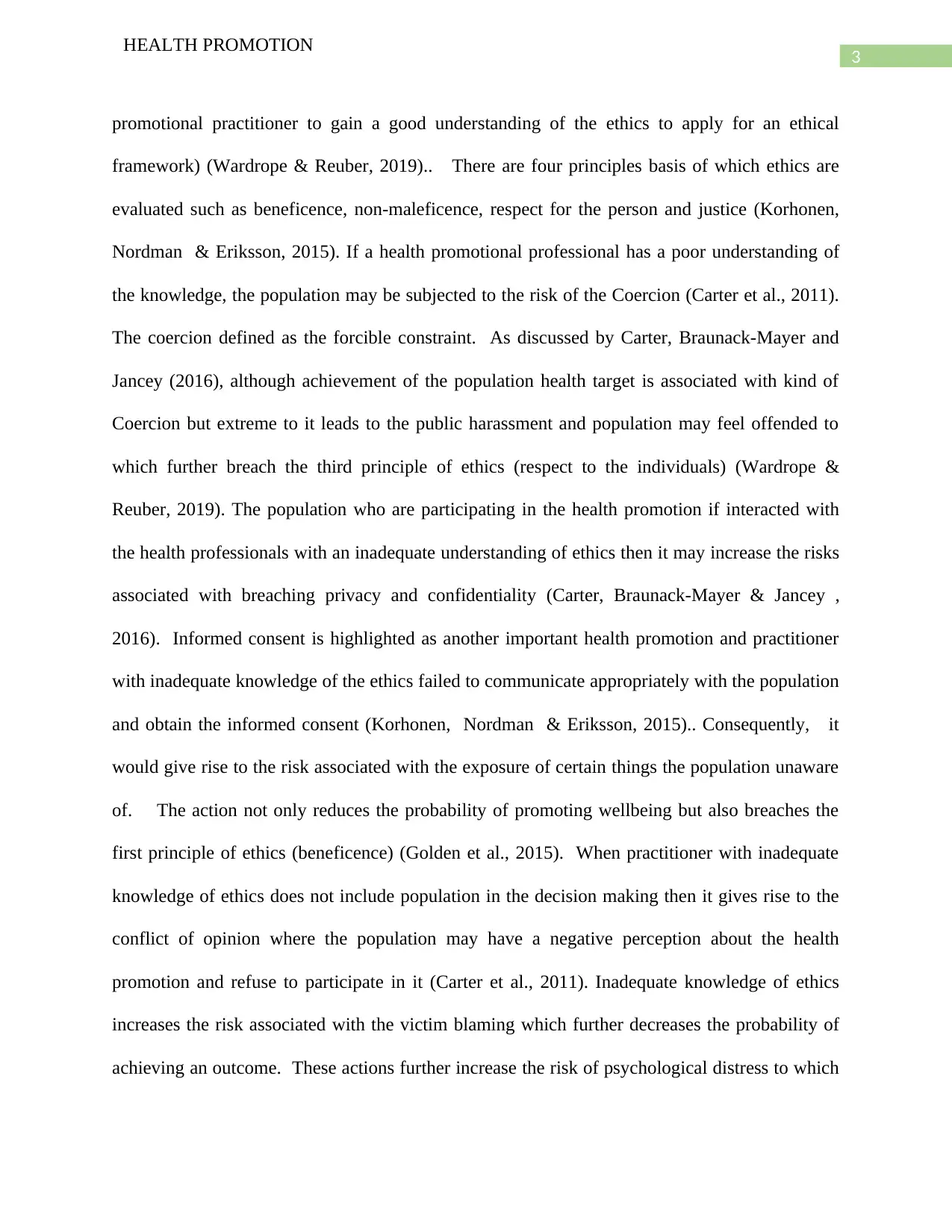
3
HEALTH PROMOTION
promotional practitioner to gain a good understanding of the ethics to apply for an ethical
framework) (Wardrope & Reuber, 2019).. There are four principles basis of which ethics are
evaluated such as beneficence, non-maleficence, respect for the person and justice (Korhonen,
Nordman & Eriksson, 2015). If a health promotional professional has a poor understanding of
the knowledge, the population may be subjected to the risk of the Coercion (Carter et al., 2011).
The coercion defined as the forcible constraint. As discussed by Carter, Braunack-Mayer and
Jancey (2016), although achievement of the population health target is associated with kind of
Coercion but extreme to it leads to the public harassment and population may feel offended to
which further breach the third principle of ethics (respect to the individuals) (Wardrope &
Reuber, 2019). The population who are participating in the health promotion if interacted with
the health professionals with an inadequate understanding of ethics then it may increase the risks
associated with breaching privacy and confidentiality (Carter, Braunack-Mayer & Jancey ,
2016). Informed consent is highlighted as another important health promotion and practitioner
with inadequate knowledge of the ethics failed to communicate appropriately with the population
and obtain the informed consent (Korhonen, Nordman & Eriksson, 2015).. Consequently, it
would give rise to the risk associated with the exposure of certain things the population unaware
of. The action not only reduces the probability of promoting wellbeing but also breaches the
first principle of ethics (beneficence) (Golden et al., 2015). When practitioner with inadequate
knowledge of ethics does not include population in the decision making then it gives rise to the
conflict of opinion where the population may have a negative perception about the health
promotion and refuse to participate in it (Carter et al., 2011). Inadequate knowledge of ethics
increases the risk associated with the victim blaming which further decreases the probability of
achieving an outcome. These actions further increase the risk of psychological distress to which
HEALTH PROMOTION
promotional practitioner to gain a good understanding of the ethics to apply for an ethical
framework) (Wardrope & Reuber, 2019).. There are four principles basis of which ethics are
evaluated such as beneficence, non-maleficence, respect for the person and justice (Korhonen,
Nordman & Eriksson, 2015). If a health promotional professional has a poor understanding of
the knowledge, the population may be subjected to the risk of the Coercion (Carter et al., 2011).
The coercion defined as the forcible constraint. As discussed by Carter, Braunack-Mayer and
Jancey (2016), although achievement of the population health target is associated with kind of
Coercion but extreme to it leads to the public harassment and population may feel offended to
which further breach the third principle of ethics (respect to the individuals) (Wardrope &
Reuber, 2019). The population who are participating in the health promotion if interacted with
the health professionals with an inadequate understanding of ethics then it may increase the risks
associated with breaching privacy and confidentiality (Carter, Braunack-Mayer & Jancey ,
2016). Informed consent is highlighted as another important health promotion and practitioner
with inadequate knowledge of the ethics failed to communicate appropriately with the population
and obtain the informed consent (Korhonen, Nordman & Eriksson, 2015).. Consequently, it
would give rise to the risk associated with the exposure of certain things the population unaware
of. The action not only reduces the probability of promoting wellbeing but also breaches the
first principle of ethics (beneficence) (Golden et al., 2015). When practitioner with inadequate
knowledge of ethics does not include population in the decision making then it gives rise to the
conflict of opinion where the population may have a negative perception about the health
promotion and refuse to participate in it (Carter et al., 2011). Inadequate knowledge of ethics
increases the risk associated with the victim blaming which further decreases the probability of
achieving an outcome. These actions further increase the risk of psychological distress to which
Paraphrase This Document
Need a fresh take? Get an instant paraphrase of this document with our AI Paraphraser
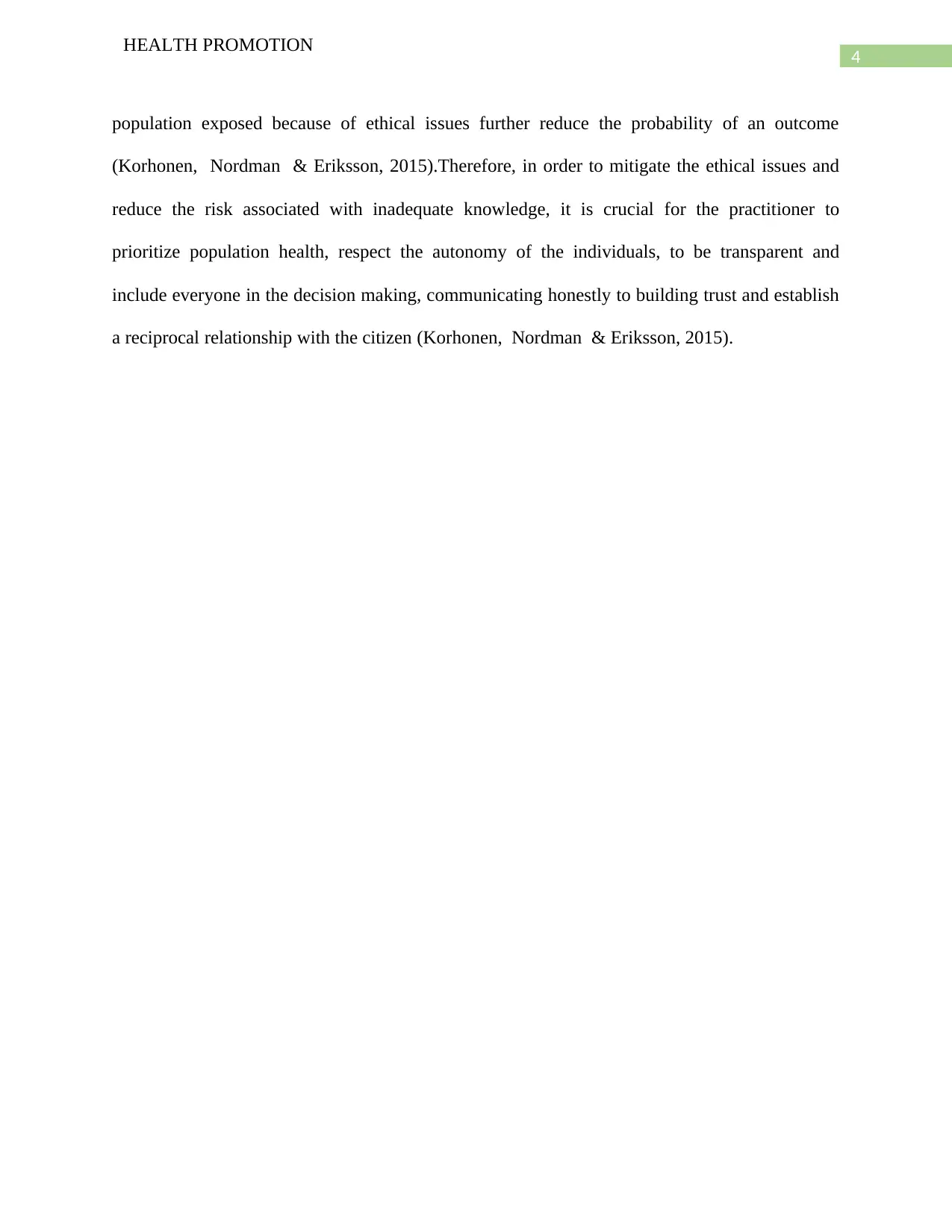
4
HEALTH PROMOTION
population exposed because of ethical issues further reduce the probability of an outcome
(Korhonen, Nordman & Eriksson, 2015).Therefore, in order to mitigate the ethical issues and
reduce the risk associated with inadequate knowledge, it is crucial for the practitioner to
prioritize population health, respect the autonomy of the individuals, to be transparent and
include everyone in the decision making, communicating honestly to building trust and establish
a reciprocal relationship with the citizen (Korhonen, Nordman & Eriksson, 2015).
HEALTH PROMOTION
population exposed because of ethical issues further reduce the probability of an outcome
(Korhonen, Nordman & Eriksson, 2015).Therefore, in order to mitigate the ethical issues and
reduce the risk associated with inadequate knowledge, it is crucial for the practitioner to
prioritize population health, respect the autonomy of the individuals, to be transparent and
include everyone in the decision making, communicating honestly to building trust and establish
a reciprocal relationship with the citizen (Korhonen, Nordman & Eriksson, 2015).
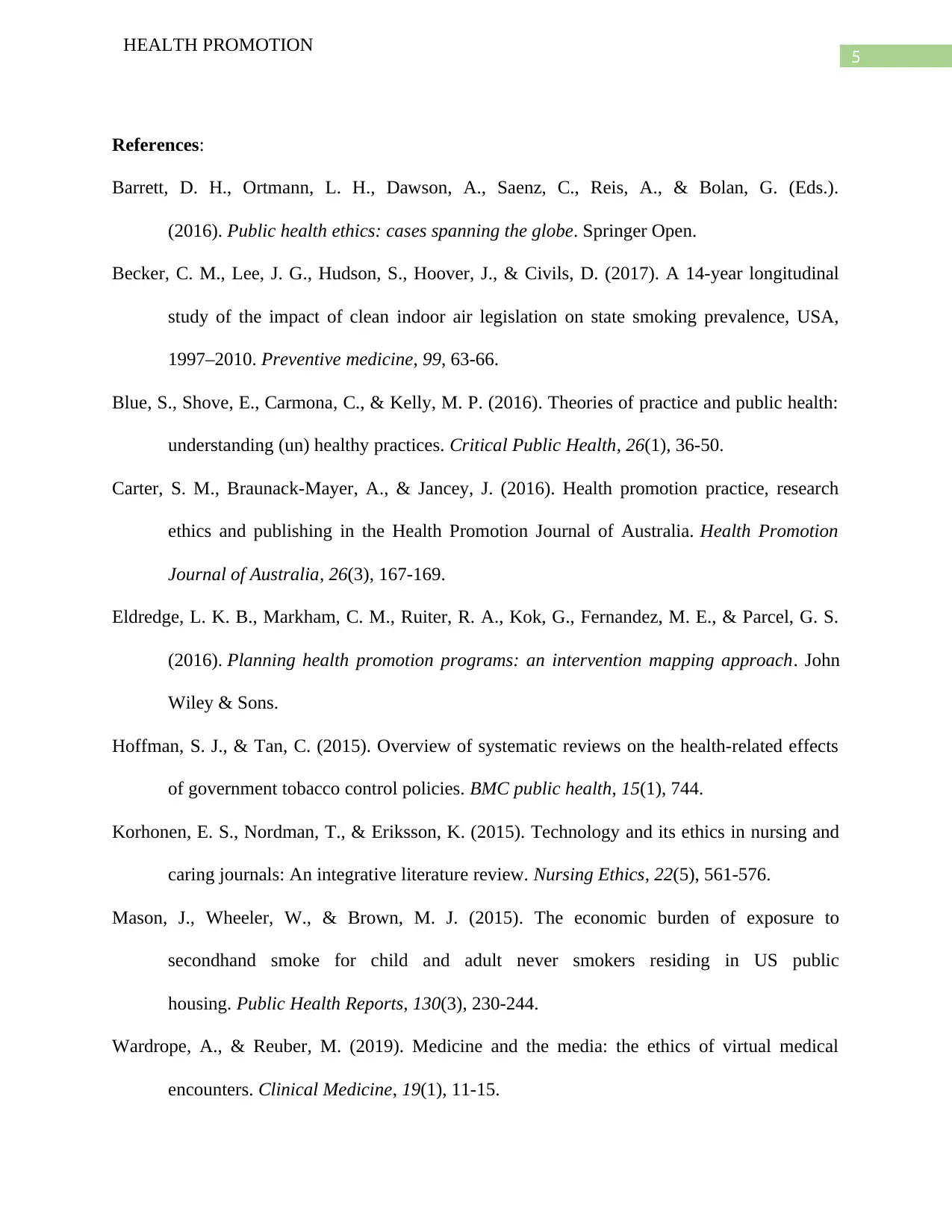
5
HEALTH PROMOTION
References:
Barrett, D. H., Ortmann, L. H., Dawson, A., Saenz, C., Reis, A., & Bolan, G. (Eds.).
(2016). Public health ethics: cases spanning the globe. Springer Open.
Becker, C. M., Lee, J. G., Hudson, S., Hoover, J., & Civils, D. (2017). A 14-year longitudinal
study of the impact of clean indoor air legislation on state smoking prevalence, USA,
1997–2010. Preventive medicine, 99, 63-66.
Blue, S., Shove, E., Carmona, C., & Kelly, M. P. (2016). Theories of practice and public health:
understanding (un) healthy practices. Critical Public Health, 26(1), 36-50.
Carter, S. M., Braunack-Mayer, A., & Jancey, J. (2016). Health promotion practice, research
ethics and publishing in the Health Promotion Journal of Australia. Health Promotion
Journal of Australia, 26(3), 167-169.
Eldredge, L. K. B., Markham, C. M., Ruiter, R. A., Kok, G., Fernandez, M. E., & Parcel, G. S.
(2016). Planning health promotion programs: an intervention mapping approach. John
Wiley & Sons.
Hoffman, S. J., & Tan, C. (2015). Overview of systematic reviews on the health-related effects
of government tobacco control policies. BMC public health, 15(1), 744.
Korhonen, E. S., Nordman, T., & Eriksson, K. (2015). Technology and its ethics in nursing and
caring journals: An integrative literature review. Nursing Ethics, 22(5), 561-576.
Mason, J., Wheeler, W., & Brown, M. J. (2015). The economic burden of exposure to
secondhand smoke for child and adult never smokers residing in US public
housing. Public Health Reports, 130(3), 230-244.
Wardrope, A., & Reuber, M. (2019). Medicine and the media: the ethics of virtual medical
encounters. Clinical Medicine, 19(1), 11-15.
HEALTH PROMOTION
References:
Barrett, D. H., Ortmann, L. H., Dawson, A., Saenz, C., Reis, A., & Bolan, G. (Eds.).
(2016). Public health ethics: cases spanning the globe. Springer Open.
Becker, C. M., Lee, J. G., Hudson, S., Hoover, J., & Civils, D. (2017). A 14-year longitudinal
study of the impact of clean indoor air legislation on state smoking prevalence, USA,
1997–2010. Preventive medicine, 99, 63-66.
Blue, S., Shove, E., Carmona, C., & Kelly, M. P. (2016). Theories of practice and public health:
understanding (un) healthy practices. Critical Public Health, 26(1), 36-50.
Carter, S. M., Braunack-Mayer, A., & Jancey, J. (2016). Health promotion practice, research
ethics and publishing in the Health Promotion Journal of Australia. Health Promotion
Journal of Australia, 26(3), 167-169.
Eldredge, L. K. B., Markham, C. M., Ruiter, R. A., Kok, G., Fernandez, M. E., & Parcel, G. S.
(2016). Planning health promotion programs: an intervention mapping approach. John
Wiley & Sons.
Hoffman, S. J., & Tan, C. (2015). Overview of systematic reviews on the health-related effects
of government tobacco control policies. BMC public health, 15(1), 744.
Korhonen, E. S., Nordman, T., & Eriksson, K. (2015). Technology and its ethics in nursing and
caring journals: An integrative literature review. Nursing Ethics, 22(5), 561-576.
Mason, J., Wheeler, W., & Brown, M. J. (2015). The economic burden of exposure to
secondhand smoke for child and adult never smokers residing in US public
housing. Public Health Reports, 130(3), 230-244.
Wardrope, A., & Reuber, M. (2019). Medicine and the media: the ethics of virtual medical
encounters. Clinical Medicine, 19(1), 11-15.
⊘ This is a preview!⊘
Do you want full access?
Subscribe today to unlock all pages.

Trusted by 1+ million students worldwide
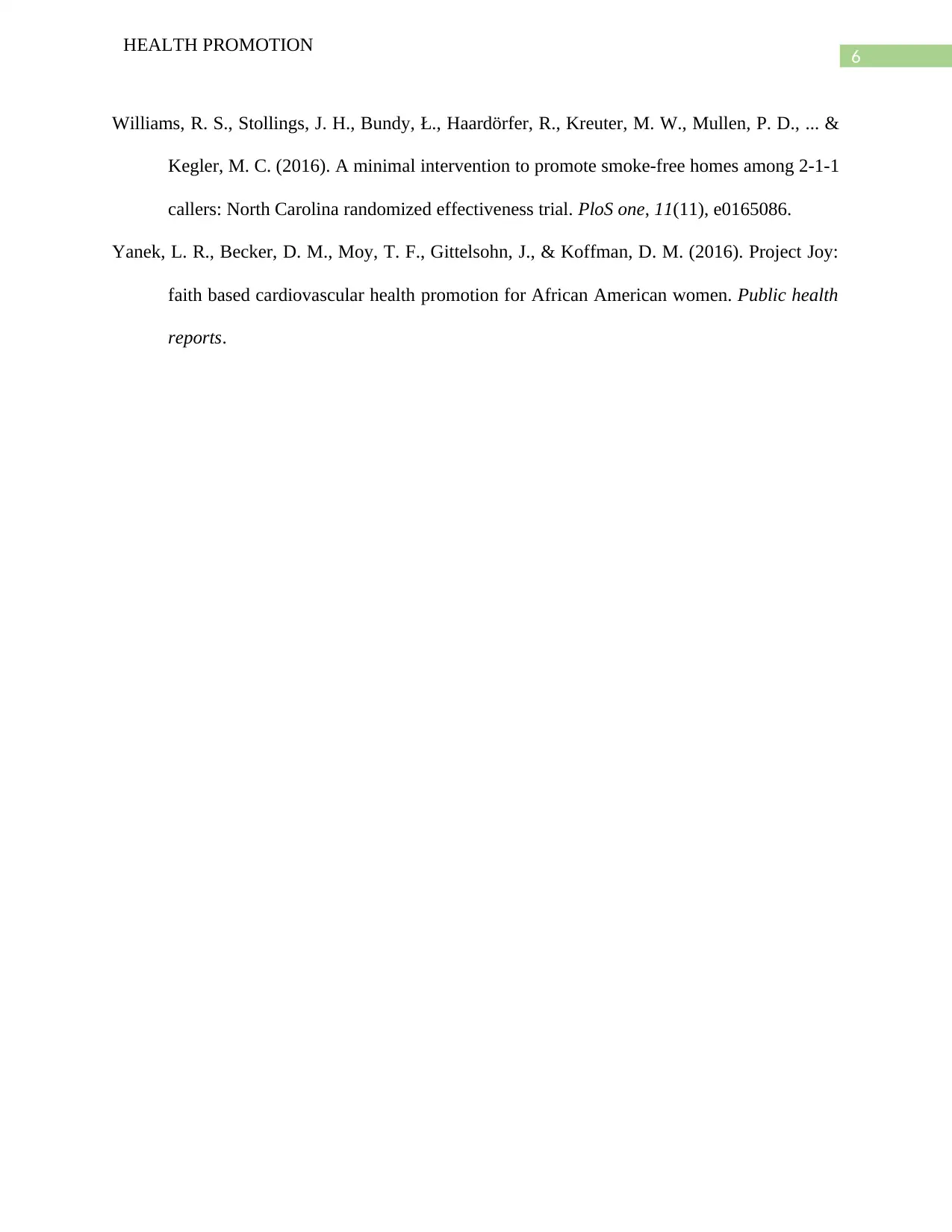
6
HEALTH PROMOTION
Williams, R. S., Stollings, J. H., Bundy, Ł., Haardörfer, R., Kreuter, M. W., Mullen, P. D., ... &
Kegler, M. C. (2016). A minimal intervention to promote smoke-free homes among 2-1-1
callers: North Carolina randomized effectiveness trial. PloS one, 11(11), e0165086.
Yanek, L. R., Becker, D. M., Moy, T. F., Gittelsohn, J., & Koffman, D. M. (2016). Project Joy:
faith based cardiovascular health promotion for African American women. Public health
reports.
HEALTH PROMOTION
Williams, R. S., Stollings, J. H., Bundy, Ł., Haardörfer, R., Kreuter, M. W., Mullen, P. D., ... &
Kegler, M. C. (2016). A minimal intervention to promote smoke-free homes among 2-1-1
callers: North Carolina randomized effectiveness trial. PloS one, 11(11), e0165086.
Yanek, L. R., Becker, D. M., Moy, T. F., Gittelsohn, J., & Koffman, D. M. (2016). Project Joy:
faith based cardiovascular health promotion for African American women. Public health
reports.
1 out of 7
Related Documents
Your All-in-One AI-Powered Toolkit for Academic Success.
+13062052269
info@desklib.com
Available 24*7 on WhatsApp / Email
![[object Object]](/_next/static/media/star-bottom.7253800d.svg)
Unlock your academic potential
Copyright © 2020–2025 A2Z Services. All Rights Reserved. Developed and managed by ZUCOL.





